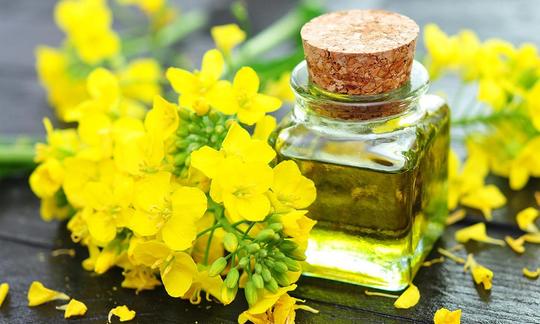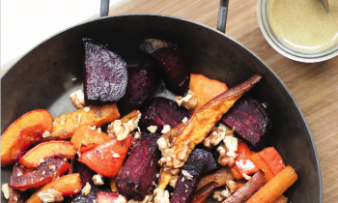Table of contents
Rapeseed oil is known as canola oil, rapeseed oil, rapeseed kernel oil or HOLL oil and boasts a favorable fatty acid profile. Cold-pressed rapeseed oil is characterized by a high content of omega-3 fatty acids and a balanced ratio of polyunsaturated fatty acids. The oil is obtained from the seeds of the rapeseed plant ( Brassica napus) .
Use in the kitchen:
Cold-pressed rapeseed oil is amber to honey-colored and has a mild, slightly nutty flavor. It is best used in cold cooking for salad dressings, vegan mayonnaise, dips, marinades, with raw food or to refine cooked dishes. Native rapeseed oil has a lower smoke point than refined rapeseed oil and is only suitable for gentle steaming. Native rapeseed oil decomposes at temperatures above 140 °C 1. In order not to destroy the valuable ingredients and to avoid the formation of harmful decomposition products (such as trans fats), cold-pressed rapeseed oil should not be heated or should only be heated gently.
Refined rapeseed oil is light yellow, tasteless, universally applicable and suitable for gentle baking, frying and cooking up to about 180 °C 2. But even refined rapeseed oil should not be heated too high: if it smokes, it is too hot (keyword: smoke point). 1
Can you use rapeseed oil for frying? HOLL rapeseed oil (High Oleic Low Linolenic) contains natural coloring and flavorings and is suitable for hot frying, deep-frying, cooking, steaming and baking up to about 210 °C. 3 Oil heated above the smoke point is best disposed of, as harmful substances such as trans fats, peroxides or acrylamide are formed. In addition, there is an oxidative and thermal breakdown of vitamin E and polyunsaturated fatty acids. 1 We generally recommend avoiding high heat and steaming gently or preferring raw food. With a pure raw food diet, you can completely avoid the intake of harmful trans fats and Maillard molecules (more on this in this book review, for example).
Vegan recipe for mayonnaise with cold-pressed rapeseed oil:
To make homemade mayonnaise a success, all ingredients should be at room temperature. First, mix 200 ml of neutral-tasting soy milk with 3 teaspoons of mustard and 4 teaspoons of lemon juice . While constantly mixing, add 250 ml of cold-pressed rapeseed oil in a thin thread until it reaches a creamy, firm consistency. Finally, season the mayonnaise to taste with salt ,pepper, agave syrup and vinegar .
| Not only vegans or vegetarians should read this: Vegans often eat unhealthily. Avoidable nutritional errors . |
Shopping - where to buy?
Is rapeseed oil cold-pressed? Rapeseed oil is available in different qualities and price ranges from many supermarket chains, e.g. Coop, Migros, Denner, Volg, Spar, Aldi, Lidl, Rewe, Edeka or Hofer, but also in health food stores, organic shops, drugstores and organic supermarkets such as Denns or Alnatura . As a local product - in conventional or organic quality - rapeseed oil is environmentally friendly because long transport routes are eliminated. 2
Cold-pressed rapeseed oil comes from mechanical and as gentle a pressing as possible without external heat. However, the raw material may be heat-treated before processing. 4.5
Virgin rapeseed oil is a natural oil that is made from rapeseed that has not been preheated. It is also cold-pressed or obtained through other gentle mechanical processes. 4.5
The term "extra virgin" is a reference to the highest quality level within the EU ( European Union ) and means that the rapeseed oil comes from first pressing and is of particularly high quality. 4
Rapeseed oil described as "unrefined" can be obtained by melting or gentle mechanical processes such as pressing and centrifuging. Unrefined oil can be steamed to increase shelf life and reduce undesirable contaminants. 5,6
Cold-pressed oils (laws, raw food)
In Switzerland, an oil is referred to as cold-pressed if the oilseed was not heated, the pressing temperature did not exceed 50 °C and no problematic post-treatment took place.
According to the Federal Department of Home Affairs ( FDHA ), an edible oil is considered cold-pressed (or may be described with synonyms such as (extra) virgin, unrefined, cold-pressed or natural) if it is obtained by pressing or centrifuging from previously unheated raw materials, the temperature during pressing did not exceed 50 °C and no refining, i.e. no neutralisation, no treatment with adsorbents, bleaching earth or steaming was required.
An oil may be described as “gently steamed” if the refining process was limited to steaming and the temperature did not exceed 130 °C. 17
In the EU and the USA, there does not appear to be a generally applicable temperature limit set by law for cold-pressed oils. For example, the guidelines for edible fats and oils of the Federal Ministry of Food and Agriculture (D) are similar to the EDI regulation, but they do not specify a permissible maximum temperature for general cold pressing - since they only apply to products whose labelling and composition are not conclusively set by law (i.e. not for olive oil, cocoa butter, milk fats, spreadable fats, for example). 18
On the other hand, both the EU directives and the amendment to the EDI regulation on foods of plant origin, mushrooms and table salt (and its amendment) provide for a special rule for the labelling of olive oils . 19,20
These are selective marketing rules in which the term raw food is not defined. "Raw food" and "raw" are therefore not state-protected terms (as is the case with the term "organic"), which leaves a lot of room for interpretation. Although it is agreed that with purely mechanical cold pressing, the pressing temperatures generally do not exceed 40 °C, one should not naively assume that cooking oils are raw food quality. There is a suspicion that the measuring method used does not indicate the temperature in the press cylinder (where the heat is highest), but only the outlet temperature in the oil hose. With water-cooled olive oil presses (so-called "water-cooled 37°" oil presses), one probably cannot even say with certainty what the exact temperature is inside the press cylinder, because the entire press cylinder is surrounded by cooling sleeves.
In addition, the pressing pressure and speed as well as the moisture content of the oilseed affect the pressing temperature. If, for example, the moisture content is too low, the temperature rises during pressing and it is difficult to stay even below the maximum limit of 50 °C. 21
High-oleic rapeseed oil or HOLL rapeseed oil comes from special types of rapeseed that have been bred to have a higher oleic acid content and a lower omega-3 fatty acid content. They are cold-pressed, then treated with steam and also contain natural coloring and flavorings. 3
Industrially produced rapeseed oil is obtained by hot pressing and the use of solvents. During the subsequent refining process, the undesirable accompanying substances are removed, resulting in an oil that is odorless and tasteless. 6
Rapeseed oil is made from peeled rapeseed, while unpeeled seeds are used for rapeseed oil. This gives cold-pressed rapeseed oil a particularly mild taste. 7 The German Society for Fat Sciences ( DGF ) tests native rapeseed oils and has been awarding DGF rapeseed oil medals for excellent taste every year since 2006. 7
Storage:
Cold-pressed or native rapeseed oil is sensitive to heat, light, water, atmospheric oxygen and foreign odors. Because of its high content of polyunsaturated fatty acids, it should be stored in a cool, dark place, well packaged and sealed. Opened rapeseed oil is best stored in the refrigerator. It should be used up within four to eight weeks and stored in containers that are as full as possible. The less oil there is in the container, the more atmospheric oxygen can come into contact with the rapeseed oil and lead to faster spoilage through oxidation. Original sealed containers of cold-pressed rapeseed oil can be stored in a cool, dark place for about six months to a year. Spoiled rapeseed oil can be recognized by its unpleasant rancid taste. 8,9
Refined and HOLL rapeseed oils should also be stored in a cool, dark place and tightly closed. Original sealed containers can be stored for around two years.
Ingredients - nutritional value - calories:
When it comes to rapeseed oil, the weight per liter is important: How heavy is 1 liter of rapeseed oil? The temperature and type of oil are important here. For 1 kg of rapeseed oil, you need about 1.085 liters with a density of about 0.92 kg/l (specific weight).
The fatty acids in rapeseed oil are mainly made up of 51-70% oleic acid, 15-30% (19 g/100g) linoleic acid (omega-6 fatty acid, LA), 3-12% (9.1 g/100g) alpha-linolenic acid (omega-3 fatty acid, ALA) and 7.4% saturated fatty acids. Rapeseed oil therefore has a nutritionally very favorable ratio of 2:1 (LA:ALA). 9,10 Far less favorable ratios are found in olive oil (12:1), grape seed oil (696:1), sunflower oil and peanut oil or safflower oil (practically no ALA). According to recommendations from the Federal Nutrition Commission ( EEK ), the average daily ratio should not exceed 5:1.
Higher levels of omega-3 fatty acids can be found in linseed oil (53 g/100g), hemp oil (16 g/100g) or walnut oil (10 g/100g). All of these oils are therefore even more difficult to store. They also score points with a good LA:ALA ratio (5:1 for walnut oil, 4:1 for hemp oil and even 1:4 for linseed oil). 10
Migros provides information on the ratio of fatty acids in HOLL rapeseed oil on the Internet 16 . Here too, the LA:ALA ratio remains better than in olive oil.
Erucic acid, an omega-9 fatty acid, which is a health hazard, is hardly found in the rapeseed varieties used today, at 0-2%. Breeding rapeseed has also largely eliminated the originally occurring, sharp-tasting mustard oil glycosides (glucosinolates) from rapeseed. For this reason, modern rapeseed varieties are referred to as "double zero" or "00 varieties". 9,10
Native rapeseed oil contains vitamin K and 17 mg/100g vitamin E as so-called accompanying substances. Vitamin E acts as a natural antioxidant and protects the rapeseed oil from spoilage. An average of 10% is lost during cooking due to preparation processes and oxidation. More vitamin E is found in unpeeled hemp seeds (90 mg/100g), in almonds (25.6 g/100g) or in hazelnuts (15 g/100g). 1.10
Rapeseed oil may also contain a small amount of table salt (approx. 15-20 mg/100g).
We believe it is wrong to describe rapeseed oil as a superfood because of its good fatty acid profile and the antioxidant-effective vitamin E. Oils and fats should generally be consumed in moderation. Some prominent doctors in the USA, especially heart specialists, are actively promoting a diet without oil. No oil is actually healthy; it is an unnatural concentrate, like white sugar. There are enough seeds and nuts to cover your needs.
You can find all the ingredients, the coverage of the daily requirement and comparison values with other ingredients in our nutrient tables. In the article Nutrients explained you will get a detailed insight into the topic.
Health aspects - effects:
How healthy is rapeseed oil? Not only polyunsaturated fatty acids can reduce the amount of undesirable LDL cholesterol (LDL = English abbreviation for low density lipoprotein) in the blood, but also the monounsaturated oleic acid found in rapeseed oil in a similar way. Since oleic acid only has one double bond in its chemical structure, the body prefers to incorporate it into LDL particles. Oleic acid, which is less susceptible to oxidation, leads to less plaque formation in the arteries and thus to a lower risk of arteriosclerosis. 9
The hormone-like substances EPA eicosapentaenoic acid and DHA docosahexaenoic acid, which are formed from omega-3 fatty acids, have antithrombotic, anti-inflammatory and bronchodilating and vasodilating effects. 11
When it comes to the questions "What is the healthiest oil" or "What is better, rapeseed oil or olive oil" or "What is better, rapeseed oil or sunflower oil", it can be said that it basically depends on the amount used, the intended purpose and the fatty acid composition. There are vegetable oils and fats that should be avoided and others that should be preferred if you want to use oil in addition to whole foods such as nuts, seeds, olives or avocados. High-quality, cold-pressed rapeseed oil, linseed oil or walnut oil are recommended for cold use and more heat-stable oils such as HOLL rapeseed oil for gentle warm use. 16 Rapeseed oil also has secondary plant substances such asbeta-sitosterol - with 413 mg/100ml. 10 Because of their extremely high content of omega-6 fatty acids, you should avoidsunflower oil, peanut oil, grape seed oil or safflower oil, as well as palm oil or coconut oil, which are rich in saturated fatty acids. 12
Even though the fatty acid ratio of cold-pressed and refined rapeseed oil is relatively similar, there are differences in the composition of the various fatty acids - for example, the content of the omega-3 fatty acid α-linolenic acid. Through refining, rapeseed oil loses vitamins and other fatty substances (carotenoids, etc.) as well as secondary plant substances. This is why the color and taste change very significantly.
Dangers - Intolerances - Side effects:
Excessive intake of polyunsaturated fatty acids (e.g. through oil, food supplements, enriched ready-made products) leads to an increased formation of potentially harmful oxidation products. A natural diet with plenty of fresh vegetables and fresh fruit provides antioxidants that render the oxidation products in the body harmless. Vitamin E plays a special role in neutralizing lipid peroxide radicals. 9,12
In non-cultivated rapeseed varieties, the harmful erucic acid (fatty acid) makes up more than half of the total fatty acids. Erucic acid causes organ damage and heart problems in humans and mammals. The rapeseed oils used today as cooking oils hardly contain any erucic acid. 7,13 According to the EFSA ( European Food Safety Authority ), the average consumer exposure for all age groups is between 0.3 and 4.4 mg/kg per day. Dietary exposure to erucic acid is mainly due to pastries, cakes and biscuits, and in the case of infants, to infant formula. 14
When rapeseed oil is heated, changes occur within the fatty acids in addition to the breakdown of fatty acids. At temperatures of around 140-150 °C, potentially harmful trans fatty acids (TFA) are formed from unsaturated fatty acids. Higher levels of polyunsaturated fatty acids promote the formation of TFA. With average use in the kitchen, cold-pressed or refined oils lead to an increase in trans fatty acids from 0.02% or 1.5% to a maximum of 2% (measured during an experimental frying time of 54 hours). TFA formed during the refining of oils make up an average of 1% of the total fatty acids. According to current knowledge, these low levels of trans fatty acids due to refining or normal kitchen temperatures are not relevant. 1
Occurrence - Origin:
According to Wikipedia, the genetic center of rapeseed is in the eastern Mediterranean. The plant, known to the Romans, has been cultivated for centuries to produce oil. 2 However, rapeseed oil from old varieties used to have a high proportion of bitter substances (glucosinolates, mustard oil glycosides). It also contained acids that were nutritionally questionable, such as erucic acid, gondoic acid, gadoleic acid and nervonic acid. This is why rapeseed oil was initially used mainly as lamp oil, lubricant and for soap production and rarely as cooking oil. 7
At the end of the 1960s, Canada succeeded in breeding rapeseed varieties with low levels of erucic acid and bitter substances from rapeseed ( Brassica rapa ssp. oleifera ), a close relative of rapeseed ( Brassica napus ). In the 1970s, 0 rapeseed was developed as a contrast to normal rapeseed - and in the 1980s, 00 rapeseed was developed, which was also called canola in North America for marketing reasons (Canadian oil, low acid; today often genetically modified). 7
Today, modern rapeseed varieties are among the most important oil plants in the world. The varieties have different fatty acid compositions depending on their intended use. For example, Pluszero rapeseed (+0 rapeseed) or HEAR (High Erucic Acid Rapeseed) has been bred to produce erucic acid as an industrial raw material. This is a variety that is rich in erucic acid but low in glucosinolates. 7
Cultivation - harvest - processing:
In Europe, almost exclusively 00 rapeseed varieties are grown as winter rapeseed and only insignificant amounts (372,000 hectares in 2007) as summer rapeseed. In Germany, almost the entire cultivated area is now planted with 00 rapeseed. Between 1986 and 2009, the cultivated area in Germany increased from around 400,000 hectares to 1.47 million hectares (approx. 12% of the cultivated area). In 2009, a total harvest of 6.21 million tonnes was achieved in Germany. 7.13
In 2008/09, the global rapeseed harvest was approximately 54.1 million tonnes, around four times more than in the early 1980s (12.7 million tonnes). 13
Areas used to grow +0 rapeseed or HEAR (High Erucic Acid Rapeseed) for the industrial use of erucic acid are contaminated with volunteer rapeseed. It is no longer permitted to grow 00 rapeseed for human consumption here. 7
Alongside palm oil and soybean oil, rapeseed oil is one of the three most produced vegetable oils worldwide, with around 29 million tonnes (2014). 1 In 2014, global rapeseed oil production was 25.9 million tonnes, according to figures from the FAO ( Food and Agriculture Organization ). The share of rapeseed oil production in total vegetable oil production for the 2008/09 financial year is estimated at 14.5%. 7
Animal protection - species protection - animal welfare:
Rapeseed is considered the most important nectar plant among agriculturally grown crops. The cultivated plant flowers in May, which is why it is considered the spring nectar for bees and insects. The nectar is the food that the bees bring in, i.e. nectar, pollen and honeydew. The nectar and pollen values of rapeseed are very high (scale: none, low, medium, high, very high). 15 Each of the bright yellow, four-petaled flowers produces nectar with a sugar content of 0.4 to 2.1 mg in 24 hours. 13 Unfortunately, deer also die if they lose their herds and have not yet learned to do without rapeseed plants in large quantities.
General information:
Rapeseed oil is the vegetable oil obtained from the seeds of the rapeseed plant ( Brassica napus ) or, less commonly, from the seeds of the rapeseed rape ( Brassica rapa ssp. oleifera ). The two oilseeds are closely related and belong to the cruciferous family (Brassicaceae or Cruciferae). 7 Although rapeseed "lost" its toxins through breeding in the 1970s and 1980s, it was still common in certain areas to eat young leaves as cut cabbage. The stems of some varieties are also used as vegetables in Asian and African cuisine. 22
Zero-quality rapeseed oils (0-rapeseed) contain small amounts of erucic acid. The oil from the double-zero rapeseed (00-rapeseed), which is the most commonly grown rapeseed today, has reduced levels of 0.5–1.5%. LEAR oil (Low Erucic Acid Rapeseed) contains almost no erucic acid at less than 0.1%. 7
What is canola oil? Canola oil from Canada (< 0.1% erucic acid) can be compared to rapeseed oil from European double-zero rapeseed varieties (00 rapeseed) that are low in erucic acid and glucosinolates. Lauric canola oil today comes from genetically modified canola plants (Laurical) and is rich in monounsaturated oleic acid and medium-chain lauric acid. 9
HO rapeseed (high oleic) has a higher oleic acid content. HOLL rapeseed or HOLLi rapeseed (high oleic low linolenic) is used to produce cooking oil. It also contains a higher proportion of monounsaturated oleic acid, while at the same time having a reduced content of omega-3 fatty acids. This increases the shelf life and heat stability of the oil. 7
Pluszero rapeseed (+0 rapeseed) contains 55% erucic acid. These varieties are known as HEAR rapeseed (High Erucic Acid Rapeseed). The erucic acid obtained is used industrially. 7
Alternative names:
Alternative names for rapeseed oil are rapeseed oil, turnip oil, colza oil, cabbage seed oil or canola. 7
Important English names are rape, rapeseed, oilseed rape, colza, coleseed, canola or canola oil.
The English term canola is primarily used in North America and Australia to refer to today's cultivated rapeseed. It can also specifically refer to (partially genetically modified) rapeseed from the USA, Canada and Australia. This is basically comparable to the European double-zero rapeseed (00 rapeseed, without genetic modifications). Ordinary rapeseed is referred to in English as rapeseed.
Keywords for use:
In 2007, three quarters of the rapeseed oil produced in Germany was used to produce biofuels or for industrial use. 13
Use in the chemical industry for technical purposes and material applications: biofuel, vegetable oil fuel, biodiesel, hydraulic oil, gear oil, saw chain oil, lubricating oil, "drilling milk", hardening oil, moonshine, burnishing, engine oil, formwork oil, varnishes, paints, solvents, surfactants, plasticizers, animal feed, crop protection products, rapeseed asphalt, candles, 7 bioplastics, biogenic lubricants. 13
Use in the pharmaceutical and cosmetic industry: medicinal ointments, cosmetic formulations. 7
By-products resulting from rapeseed oil production: rapeseed cake, rapeseed expeller or rapeseed meal as protein-rich animal feed.
Literature - Sources:
Bibliography - 22 Sources
| 1. | Ugb.de (Unabhängige Gesundheitsberatung). Wie werden ungesättigte Fettsäuren in Pflanzenölen beim Erhitzen verändert? |
| 2. | Srf.ch (Schweizer Radio und Fernsehen). Rapsöl – Verkanntes einheimisches Gold. |
| 3. | Ugb.de (Unabhängige Gesundheitsberatung). Welches Fett wofür? |
| 4. | Praxistipps.focus.de Native Öle: Wie gut sind Fette? |
| 5. | Bzfe.de (Bundeszentrum für Ernährung). Speisefette und Speiseöle. |
| 6. | Wikipedia Pflanzenöle. |
| 7. | Wikipedia Rapsöl. |
| 8. | Pharmawiki.ch Rapsöl. |
| 9. | Aid Infodienst (Herausgeber). Speisefette. 17. Auflage. Bonn; 2014. Druckerei Lokay e. K. Reinheim. |
| 10. | USDA (United States Department of Agriculture). Nährstofftabellen. |
| 11. | Leitzmann, Müller, Michel, Brehme, Triebel, Hahn, Laube. Ernährung in Prävention und Therapie. 3. Auflage. Stuttgart; 2009. Hippokrates Verlag. |
| 12. | Biesalski, Hans Konrad; Grimm, Peter; Nowitzki-Grimm, Susanne. Taschenatlas Ernährung. 6. Auflage. Stuttgart; 2015. Georg Thieme Verlag. |
| 13. | Wikipedia Raps. |
| 14. | Efsa.europa.eu (European Food Safety Authority). Erucasäure mögliches Gesundheitsrisiko für stark exponierte Kinder. |
| 15. | Kremer, Bruno P. Mein Garten – Ein Bienenparadies. 2. Auflage. Bern; 2018. Haupt Verlag. |
| 16. | Beispiele bei migros.ch: HOLL Rapsöl (Produkte - M-Classic HOLL-Rapsöl): Omega-6 (8 g/100ml) und Omega-3 (3 g/100ml) oder Schweizer HOLL Rapsöl (LeShop Schweizer HOLL-Rapsöl): Omega-6 (8 g/100ml) und Omega-3 (2 g/100ml) . |
| 17. | Verordnung des EDI über Speiseöl, Speisefett und daraus hergestellte Erzeugnisse vom 23. November 2005 (Stand am 1. April 2008), Art. 3a und 3b. |
| 18. | Bmel.de Leitsätze für Speisefette und Speiseöle. Neufassung vom 02.07.2020 (BAnz AT 18.08.2020 B3, GMBl 2020 S. 530). |
| 19. | BMEL Bundesministerium für Ernährung und Landwirtschaft. Amtsblatt der Europäischen Union. Durchführungsverordnung (EU) Nr. 29/2012 der Kommission vom 13. Januar 2012 mit Vermarktungsvorschriften für Olivenöl. Artikel 5 a) und b). 14.1.2012. |
| 20. | EDI Eidgenössisches Departement des Innern. Verordnung des EDI über Lebensmittel pflanzlicher Herkunft, Pilze und Speisesalz (VLpH). Änderung vom 8. Dezember 2023. Inkrafttreten: 1. Februar 2024. |
| 21. | Schaufler D. Oilseed Fact Sheet: Oilseed Presses. Dept. of Agricultural and Biological Engineering, Penn State College of Agricultural Sciences. |
| 22. | Ondereschka K et al. Gehäufte Rehwildverluste nach Aufnahme von 00-Raps. Zeitschrift für Jagdwissenschaft. Volume 33, Number 3, 191–205. |











Comments